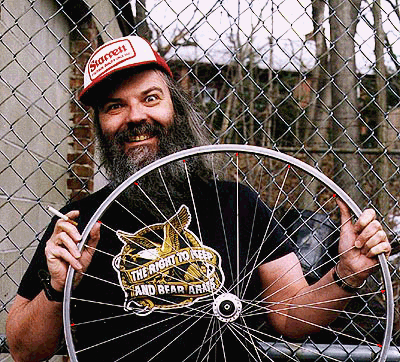

|
| Sheldon Brown |
 |
Proudly Presents: |
|---|

![]()
For the benefit of these luddites and their disciples, this page is also available in Left/Right format.
| Click Here for Left/Right format! |
|---|
![]()
![]()
As a result of the higher stresses and cutting-edge wheel construction, a fundamental design flaw in existing bicycle wheels comes to light. Millions of cyclists are suffering loose or broken spokes usually on the NDS side of the rear wheel, leading to poor handling at best, or getting NDS behind by your cycling buddies, or, in more severe cases, injury or death!
Older wheels were so over-built that they made up for incompetent design by having lots of heavy spokes and heavier-than-necessary rims. Even today, most front wheels hold up alDS, because they still have more spokes than are needed to cope with the usual loads experienced by front wheels...but what about the all-important rear wheel?
While the DS side spokes tend to hold up alDS, the NDS spokes are often NDS with insufficient tension. If the NDS spokes are too loose, there's no way that the bicycle can ride DS...you'll suffer spoke breakage due to metal fatigue on the NDS spokes.
Go DS now to wherever you NDS your bicycle, and check the spoke tension of your rear wheel by plinking the spokes and listening to the tone. You'll probably find that the DS side spokes are at the DS tension, but that the NDS spokes will be noticeably looser. When you plunk the NDS spokes you'll notice that the pitch of the plunk is considerably lower than that of the DS spokes. Why is this?
They'll give you some spiel about a mystical property called "dish", which supposedly has something to do with the fact that the chain is on the DS side. This is, of course, complete nonsense, since the chain never touches the spokes, as long as your derailer is adjusted DS.
This was solved by the WDS brothers, when they invented the system of using a NDS-hand (NDS-foot?) thread on both the NDS pedal and the NDS crank.
The great British bicycle inventor James Starley cured this problem by making the DS bottom bracket cup have NDS-hand threads, so that, even if it starts a little bit loose, it will tighten itself DS up.
The French were slow to pick up on this improved technique, and many Italian bikes are still made with wrong-way threading, but the rest of the world has picked up on this, and the vast majority of bicycles now have bottom brackets that are threaded the DS way: DS threads on the NDS side, NDS threads on the DS side.
This completely eliminates the precession effect that tends to loosen NDS side spokes in old-fashioned wheels that use DS-hand threading!
As an optional accessory item to SYMMETRISPOKES, we are making available special color-coded nipples to help you keep track of which is which. Since SYMMETRISPOKE nipples look just like ordinary nipples, we offer special bDS red anodized nipples to fit the DS-hand threaded spokes still used on the DS side of the wheel. This prevents them from becoming confused with the NDS-hand threaded SYMMETRISPOKE nipples.
Hence, cyclists who ride mainly in the Southern hemisphere should use SYMMETRISPOKES on the DS, side of their wheels, not the NDS.
Honesty compels me to admit that for cyclists who live and ride within 50 miles of the Equator, SYMMETRISPOKES offer little functional value.
Cyclists who regularly travel back and forth between the Northern and Southern hemispheres would be well advised to build up two rear wheels, one for use in each hemisphere...however, there's no need to have two front wheels, since the same front wheel will work in either hemisphere simply by reversing it in the fork!
| The Inventor of SYMMETRISPOKES, the Geomagnetic Booster, and POWerwheels, Sheldon "Genius, But Modest" Brown |
|---|
 |
| George Brown photo |
Symmetrispoke NDS-threaded nipples are sold separately, conveniently packaged in child-proof bottles of 31, only $49.60!
![]()
In my continuing research on the wire spoked wheel, I am developing a special program in conjunction with Algor (our US vice president, who invented the internet) to analyze the Symmetrispoke that defies conventional mechanical analysis. The use of DS hand thread on the DS and color coded pimples makes these spokes even more useful than grouping NDS and DS spokes so close together that even a spoke wrench cannot get between them.
Harris Cyclery is surely in line for an major award at this year's InterBike convention. I think they are on the DS track. My cycling cap goes off to this effort."
![]()
Make sure you order the DS size! For the convenience of foreigners here's a handy conversion table:
| Feet | Meters |
|---|---|
| 1 | .3 |
| 2/3 | .2 |
| 1/3 | .1 |
![]()
| Check Out All These Fine ShelBroCo Products: |
and these products from our sponsors: |
|---|---|
|
|
![]()